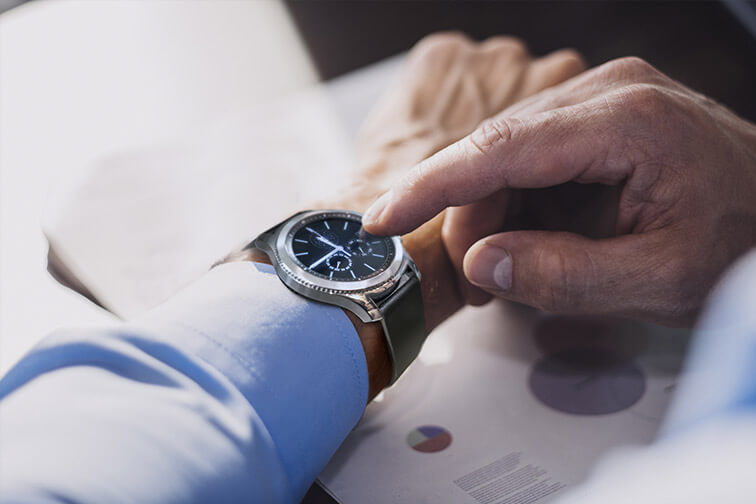Technology permeates today’s event planning and administration requirements, from ensuring sufficient bandwidth, to meeting complex sound and lighting requirements, to setting up adaptable digital signage and digital whiteboards.
Many event planners continue to rely on older methods such as in-person registration and surveys to monitor attendance and gather feedback from guests, limiting their insight into the real-time status of events.
Now that’s poised to change, thanks to the increasing usage of wearable technology.
The Wearable Disruption Is Here
Wearable technology, such as the Samsung Gear S3 smartwatch, is growing increasingly popular. According to IDC’s latest forecast, the wearables market is expected to grow by 8.2 percent throughout 2018, escalating to double-digit growth in 2019 and beyond — and smartwatches are leading the charge.
When used by guests and event staff at hotels, resorts, cruise lines and other venues, wearable technology promises to add real-time awareness and intelligence to event management and communications. Face-to-face connection is a core value for event sponsors, and they want to engage attendees in events and social opportunities, not encourage even more interaction with screens. Wearables offer an unprecedented balance of digital access and personal contact, because they can deliver quick nuggets of must-have info in a controlled environment, instead of sending guests to their phones — which incur all sorts of distractions from the event.
Early adopters have seen that difference firsthand. At the Hilton America’s Leadership Conference, guests could easily use the wearables issued at check-in to exchange contact information with the colleagues, vendors and executives they met. To incentivize those interactions, Hilton used gamification to award attendees points for each exchange, which could be traded in for merchandise at the event store.
It worked — the average attendee ended up making more than 31 connections. Event participants also used the wearables to bookmark favorite places or sessions, as well as for passive access control, live mapping, and to receive alerts about upcoming activities.
Hilton organizers, meanwhile, gained unprecedented insight into attendee activity, including precise guest tracking to fuel both real-time and future decision-making for event management, traffic flow, room turns and session controls.
How Wearable Technology Tracks Event Guests
Those aren’t the only ways wearable technology can impact event management and guest experience, though. Here are 11 more examples.
Secure transactions: By registering guests’ payment credentials in advance, event organizers can offer easy payments via wearables at food concessions, stores and other venues, while ensuring that sensitive data remains secure.
Wayfinding: Used with beacons, smartwatches can help guests navigate through a conference center or a show floor, increasing their productivity and satisfaction.
Secure access: Wearables can also be programmed to act as electronic door locks for more secure access to hotel rooms. Guests no longer have to dig through their pockets to locate a key card.
Attendance: Event organizers can gain precise info not only on the number of people attending sessions and activities at an event, but who they are: VPs, women aged 18-35, or any other demographic collected at registration.
Traffic flow: Combining wearables’ location data with mapping reveals where people are congregating, dwell time and how traffic moves. That offers tremendous value for staffing, booth traffic reporting and resource planning, and managers can respond on the fly to traffic trends.
Gamification: As Hilton experienced, providing incentives for desired activities such as networking becomes fun and rewarding for guests while driving the event goals. As hilton experience, providing incentives for desired activities such as networking
Activity analysis: Disney reaps a huge amount of data from its MagicBands, and those use simple, passive RFID chips. A sophisticated wearable generates far more data, including how wearers use the devices.
Sign-ups: Instead of requiring guests to queue for an activity, organizers can enable sign-ups via the wearable and notify the guest when their turn is approaching. Universal uses its TapuTapu waterpark bracelet to tap in and reserve a place in line or trigger special effects such as a water cannon when the wearer passes by.
Itinerary and travelogue: By providing access to a dashboard, wearables help attendees plan their days, manage their schedules and then revisit their experiences afterward, through photos, contact lists, booths visited and other data about their experiences. That data can also help attendees justify future attendance.
Staff communications: By issuing wearables to event staff, organizers can communicate discreetly in real-time, for activities such as task management, dispatching and team communications.
Concierge/VIP: Event organizers can deliver enhanced VIP treatment by tracking honored guests’ movements and greeting them with everything they need, wherever they go in the event space.
Transform Event Management With Wearable Technology
Excellence in event management is all about creating an experience that delivers on organizers’ goals, then responding on the fly as imagined plans meet real-world conditions. Issuing wearable technology such as the Gear S3 smartwatch to guests and staff helps managers gain a 360-degree view of events as they unfold, while delivering an elevated, productive and exciting experience for event guests.

Lisa Terry is a seasoned B2B writer of articles, blogs, research reports, case studies, white papers and e-books, with a long list of media and corporate clients in hospitality as well as retail, IT and supply chain. She has written for Hospitality Technology, HTNG publications, Nation’s Restaurant News, RIS News, Advertising Age, Consumer Goods Technology, Inbound Logistics, Washington Technology and many others.
- Four Big IT Transformations for Enterprise Agility
- An Agile Approach, the Core of Corporate DT for Working Culture Innovation
- Digital ESG, a Critical Success Factor for ESG
- Conversational AI War Begins. Who Will Be the Winner?
- What Is Matter, the New Smart Home Standard?
- 2023 Forecast for Technology Trends
